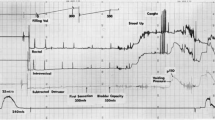Abstract
Introduction
The use of 3,4-methylenedioxymethamphetamine (MDMA, known as “ecstasy”), a synthetic amphetamine and “club drug,” has been associated with acute, transient urinary retention. We report a case of neurogenic bladder and chronic urinary retention associated with MDMA abuse.
Case report
A 21-year-old male presented to the emergency department (ED) because he had abdominal pain and difficulty urinating. He had experienced difficulty in initiating urination over the past 1.5 months, with periods of 24 to 36 hours between voids and large volumes of urine. The patient had a chronic pattern of MDMA use, taking 4 tablets/day for 3 months. Two weeks before coming to the ED, he had been admitted to an inpatient drug rehabilitation center. During the time since that admission, the patient had visited EDs repeatedly for insertion and removal of Foley catheters to relieve the urinary retention until he could be admitted to a urologic service. Cystometrogram was abnormal, finding no sensation of bladder fullness after instillation of 350 mL of saline and inability to generate a voluntary voiding pressure. Cystoscopy revealed no outlet obstruction. The findings were consistent with neurogenic bladder. The patient was given prescriptions for bethanecol and phenazopyridine, and told to continue a 10-day course of sulfamethoxazole/trimethoprim for urinary tract infection. He was discharged with a Foley catheter in place. Symptoms of urinary retention persisted at 1-year follow-up, despite self-catheterization and complete cessation of MDMA use.
Conclusion
Chronic MDMA use may lead to neurogenic bladder and chronic urinary retention.
Similar content being viewed by others
References
Grinspoon L, Bakalar JB. Can drugs be used to enhance the psychotherapeutic process?Am J Psychother 1986;40:393–404.
Greer G, Tolbert R. Subjective reports of the effects of MDMA in a clinical setting.J Psychoactive Drugs 1986;18:319–327.
Doblin R. A clinical plan for MDMA (Ecstasy) in the treatment of posttraumatic stress disorder (PTSD): partnering with the FDA.J Psychoactive Drugs 2002;34185-34194.
National Survey on Drug Use and Health,2003. Substance Abuse and Mental Health Services Administration (SAMHSA), U.S. Department of Health and Human Services.
Delgado JH, Caruso MJ, Waksman JC, Honigman B, Stillman D. Acute, transient urinary retention from combined ecstasy and methamphetamine use.J Emerg Med 2004;26:173–175.
Inman DS, Greene D. The agony and the ecstacy: acute urinary retention after MDMA abuse.BJU Int 2003;91:123.
Bryden AA, Rothwell PJ, O’Reilly PH. Urinary retention with misuse of “ecstasy.”BMJ 1995;310:504.
Gee P, Richardson S, Woltersdorf W, Moore G. Toxic effects of BZP-based herbal party pills in humans: a prospective study in Christchurch, New Zealand.N Z Med J 2005;118(1227:U1784.
Author information
Authors and Affiliations
Corresponding author
Rights and permissions
About this article
Cite this article
Beuerle, J.R., Barrueto, F. Neurogenic bladder and chronic urinary retention associated with MDMA abuse. J. Med. Toxicol. 4, 106–108 (2008). https://doi.org/10.1007/BF03160964
Issue Date:
DOI: https://doi.org/10.1007/BF03160964




